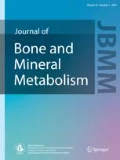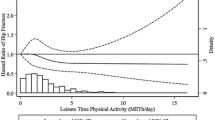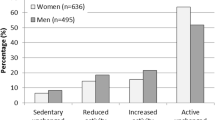Abstract
Regular physical activity is believed to have a beneficial effect on bone health but may also increase the risk of fractures by increasing the incidence of injury. We examined the association between physical activity and fracture risk in a prospective study of self-reported incident fractures among 34 696 men and women aged 20 to 89 years in the United Kingdom. Over an average of 5.2 years of follow-up, 343 men and 1555 women reported one or more fractures. For the 72% of fractures caused by a fall, the only significant association with physical activity was the lower fracture rate among women with a standing occupation compared with women in sedentary or no employment [incidence rate ratio, 0.81 (95% CI, 0.69–0.95)]. There was a strong positive association between bicycling and fracture risk: P < 0.001 for trend for both sexes. Regular participation in exercise and sports other than walking and bicycling was also associated with an increased fracture risk, and fracture rates were significantly higher for male manual workers compared with men in sedentary or no employment. These positive associations of physical activity with fracture risk applied primarily to fractures not caused by a fall. The relatively low fracture risk among women with a standing occupation might be the result of a beneficial effect of weight-bearing exercise. The markedly increased risk of fractures associated with bicycling, and the moderately increased risk associated with other exercise and sports, are probably the result of an increased incidence of injury.
Similar content being viewed by others
References
Karlsson M (2004) Has exercise an antifracture efficacy in women? Scand J Med Sci Sports 14:2–15
Conn JM, Annest JL, Gilchrist J (2003) Sports and recreation related injury episodes in the US population, 1997–99. Injury Prev 9:117–123
Delaney MF (2006) Strategies for the prevention and treatment of osteoporosis during early postmenopause. Am J Obstet Gynecol 194:S12–S23
Davey GK, Spencer EA, Appleby PN, Allen NE, Knox KH, Key TJ (2003) EPIC-Oxford: lifestyle characteristics and nutrient intakes in a cohort of 33 883 meat-eaters and 31 546 non meat-eaters in the UK. Public Health Nutr 6:259–269
Key T, Appleby P, Spencer E, Roddam A, Neale R, Allen N (2007) Calcium, diet and fracture risk: a prospective study of 1898 incident fractures among 34 696 British men and women. Public Health Nutr 10:1314–1320
Lunn M, McNeil D (1995) Applying Cox regression to competing risks. Biometrics 51:524–532
Stata Corporation (2005) Stata Statistical Software: Release 9.0. Stata Corporation, College Station, TX
Chen Z, Kooperberg C, Pettinger MB, Bassford T, Cauley JA, LaCroix AZ, Lewis CE, Kipersztok S, Borne C, Jackson RD (2004) Validity of self-report for fractures among a multiethnic cohort of postmenopausal women: results from the Women’s Health Initiative observational study and clinical trials. Menopause 11:264–274
Haftenberger M, Schuit AJ, Tormo MJ, Boeing H, Wareham N, et al (2002) Physical activity of subjects aged 50–64 years involved in the European Prospective Investigation into Cancer and Nutrition (EPIC). Public Health Nutr 5:1163–1176
Wallace BA, Cumming RG (2000) Systematic review of randomized trials of the effect of exercise on bone mass in pre-and postmenopausal women. Calcif Tissue Int 67:10–18
Nordstrom A, Olsson T, Nordstrom P (2006) Sustained benefits from previous physical activity on bone mineral density in males. J Clin Endocrinol Metab 91:2600–2604
Tang YJ, Sheu WH, Liu PH, Lee WJ, Chen YT (2007) Positive associations of bone mineral density with body mass index, physical activity, and blood triglyceride level in men over 70 years old: a TCVGHAGE study. J Bone Miner Metab 25:54–59
Thorpe DL, Knutsen SF, Beeson WL, Fraser GE (2006) The effect of vigorous physical activity and risk of wrist fracture over 25 years in a low-risk survivor cohort. J Bone Miner Metab 24:476–483
Joakimsen RM, Magnus JH, Fønnebø V (1997) Physical activity and predisposition for hip fractures: a review. Osteoporos Int 7:503–513
Gregg EW, Pereira MA, Caspersen CJ (2000) Physical activity, falls, and fractures among older adults: a review of the epidemiologic evidence. J Am Geriatr Soc 48:883–893
Verma SK, Sorock GS, Pransky GS, Courtney TK, Smith GS (2007) Occupational physical demands and same-level falls resulting in fracture in female workers: an analysis of workers’ compensation claims. Injury Prev 13:32–36
Banks E, Beral V, Reeves G, Balkwill A, Barnes I (2004) Million Women Study Collaborators: fracture incidence in relation to the pattern of use of hormone therapy in postmenopausal women. JAMA 291:2212–2220
Warner SE, Shaw JM, Dalsky GP (2002) Bone mineral density of competitive male mountain and road cyclists. Bone (NY) 30: 281–286
Department of Health (2004) At least five a week. Evidence on the impact of physical activity and its relationship to health. Department of Health, London
Shephard RJ (2003) Can we afford to exercise, given current injury rates? Inj Prev 9:99–100
Marshall SW, Guskiewicz KM (2003) Sports and recreational injury: the hidden cost of a healthy lifestyle. Inj Prev 9:100–102
Author information
Authors and Affiliations
Corresponding author
About this article
Cite this article
Appleby, P.N., Allen, N.E., Roddam, A.W. et al. Physical activity and fracture risk: a prospective study of 1898 incident fractures among 34 696 British men and women. J Bone Miner Metab 26, 191–198 (2008). https://doi.org/10.1007/s00774-007-0806-4
Received:
Accepted:
Published:
Issue Date:
DOI: https://doi.org/10.1007/s00774-007-0806-4




